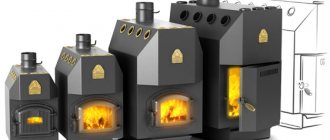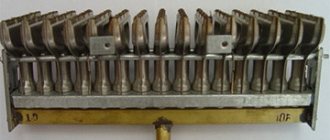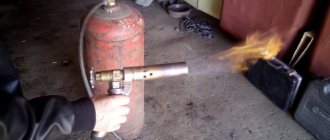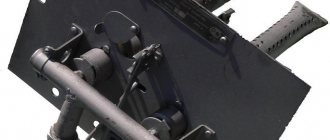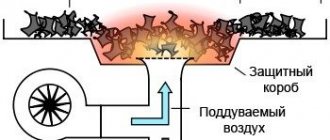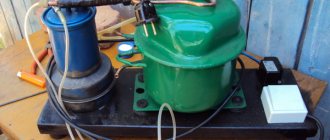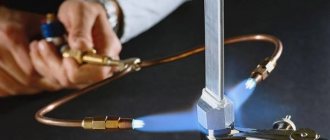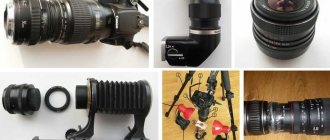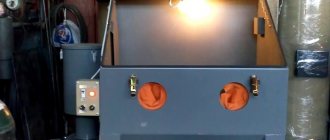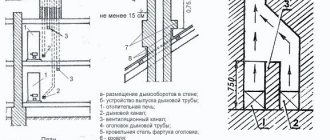The key element of the heating gas unit is the burner nozzle. It creates a mixture of fuel and air that supports combustion. If you make a gas burner for a sauna stove with your own hands, then this fact gives confidence in the reliability of the design. And this, you see, is a fairly compelling argument in favor of making your own.
You can make a nozzle for a sauna stove from scrap materials. Empty gas cylinders, scraps of metal pipes, and parts from old equipment will be used. Before commissioning, the finished product is checked by Rostechnadzor specialists.
We'll tell you how to do everything correctly. We will tell you how to obtain a certificate of suitability for a homemade gas burner. It confirms the safety of the device and allows connection to the heating system of the bathhouse.
What types of burners are there?
If a gas burner is considered from the point of view of the method of controlling thermal power, then all models can be divided into the following categories:
- Single stage. In this case, gas supply (switching off) occurs automatically, based on a rheostat signal.
- Two-stage. The burner has the design ability to switch to an economical mode. This process is regulated automatically.
- Burners with floating adjustment. The burner power can be changed smoothly, from 10 to 100 percent.
Burners are divided according to the method of air supply:
- Atmospheric. In this option, no electricity is needed; air flows to the burner under the natural action of draft. The efficiency is not very high, no more than 90 percent. This is a simple design: a pipe with holes into which fuel is supplied. It works in open combustion chambers. They can be quickly converted, if necessary, to use liquid fuel; the service life of such burners is very long. However, such burners impose increased safety requirements.
- Supercharged. They are also called blower or fan burners. This is a rather complex design. Air is supplied to the burner by a fan; in this case, the combustion chamber is closed. Efficiency exceeds 95 percent. Stoves with such burners do not require bulky chimneys. At the same time, the furnace operates stably even at low gas pressure. However, they produce a lot of noise and are volatile.
- Diffuse-kinetic. The air is partially pumped into the combustion chamber, the rest is supplied directly to the flame.
Primary requirements
We list the signs of a high-quality gas burner:
- The fuel burns completely: this requirement is very important, since incomplete combustion of gas not only reduces the efficiency of the heater, but also pollutes the atmosphere with nitrogen oxide and carbon monoxide.
- The device has a fairly long service life.
- The design is extremely simple, installation is not difficult.
- The noise emitted by the burner does not exceed the values permitted by sanitary standards.
If the burner is a combination burner, that is, it is capable of working with different types of fuel, then it should be quickly and easily switched to one or another type of fuel.
Safety rules when using burners
Failure to comply with precautions when installing and using gas burners for heating premises can lead to emergency situations and accidents: fire in the house, carbon monoxide poisoning. When operating gas equipment, you should adhere to the following rules:. When operating gas equipment, you should adhere to the following rules:
When operating gas equipment, you should adhere to the following rules:
- Observe the service life. The burner's service life, depending on the model, can range from 8 to 15 years. Then it must be replaced.
- Use models with a function that automatically turns off the device in the absence of draft or flame.
- A stove equipped with gas burner units must meet safety requirements.
The design, installation or repair of a gas burner must be carried out by certified gas service workers, with whom an agreement has been concluded for the supply of fuel and maintenance of the units.
If possible, it is still necessary to use gas boilers or special furnaces that are designed to work with natural or liquefied gas
To obtain permission to install and connect to the main gas network, a number of conditions must be met:
- compliance with the rules for connecting a gas burner;
- appropriate design of the smoke channel, its high-quality insulation;
- installing a spark arrester at the top of the chimney.
This is the minimum requirement for installing forced-air gas burners.
For atmospheric there are additional requirements:
- presence of adjustable traction;
- ensuring good ventilation;
- the volume of the room in which the gas burner is installed is from 12 m3.
If equipment is converted to use liquefied gas, it is necessary to ensure safe storage of the gas cylinder. This can be a separate room or a metal cabinet. If you plan to store gas reserves in a gas tank, then the tank is installed underground at a distance of no closer than 5 m from the building.
Gas supply to the bathroom
Sauna stoves with gas nozzles have become a technological innovation for people living far from forests. Considering the low cost of gas fuel compared to wood, the cost of heating with a burner becomes completely insignificant.
Turkish bath lovers cannot limit themselves to using such a bath every day. Only, of course, if health allows.
An uninterrupted supply of flammable gas to the sauna stove can be ensured by:
- At the back, the network is laid in the summer cottage and connected to the bathroom.
- Gas cylinders that need to be refilled periodically.
- The gas tank is installed on site, stationary or mobile, suitable for periodic refueling.
The most labor-intensive procedure will be the procedure for disconnecting the general gas system of a city or rural settlement. Purchase, installation and registration of gas meters is required. You will also need to obtain permits, technical documentation and payment.
A gas pipeline in the toilet area makes the task of providing fuel easier. Solving technical problems with connecting a reliable gas burner is not difficult
To connect a regular gas cylinder, you will also need to invite a representative of the gas service and prepare technical documentation. Tanks have special positioning requirements.
For example, gas cylinders cannot be installed in a bathhouse. They should be placed outdoors in an easily accessible, ventilated area. There must be fire protection equipment nearby: fire extinguisher, sand.
Popular gas burners for saunas
Most often, atmospheric burners of the UGOP type are installed in sauna stoves. They are available in different modifications - from 8 kW to 30 kW. There are models equipped with draft presence sensors, a gas shut-off valve, and flame control. All these options increase the safety of using gas equipment, but at the same time they raise the price and also make repairs more difficult (and expensive). There is also a temperature control function, but it is rarely found. The most popular gas burners are UGOP-16 and 12 - they are suitable for most steam rooms. Their technical characteristics are shown in the table below.
Technical characteristics of UGOP 12, 16, 30
Please note that there are dozens of manufacturers of this equipment, and some parameters may vary. Be sure to read the description and technical specifications of the specific equipment model
The description must indicate that the device can be used in sauna stoves. Before purchasing, be sure to find out the physical parameters of the burner (at least the length of the tubes) and decide whether this modification is suitable.
Burner UGOP-P 16 with micro-flare burners
Recently, a modification of this type of equipment has appeared with holes in the form of long slits-slots, rather than circles (drilled, because the holes are drilled). Due to the presence of slots, such a burner is called a slot burner. Such a seemingly insignificant detail greatly influences the combustion pattern. You can see the difference in the video.
Preparing for the manufacturing process
Having understood the structure of the gas burner and decided on the model, you can move on to the next preparatory step. Make a list of the necessary materials and tools.
The following list can be taken as a basis:
- steel tube 100 mm long and with walls 2 mm thick;
- fuel control valve;
- steel cap, piezoelectric element, rubber for handle;
- welding machine, grinder.
Don't forget about little things like connecting elements. For example, for a valve type VK-74 you need to stock up on a cap with a conical thread.
Oven nozzle
Gas stove burner is used to burn gaseous fuels such as gas. They are available as atmospheric or pulse burners. When comparing the two systems, especially the blower burners provide very clean and efficient combustion of gas products in all power ranges by precisely controlling the supply of fuel and combustion air.
Modern and compact heaters currently use mainly flat burners, in which the flame is distributed over several nozzles over a larger area. The operator's hand makes the combustion particularly efficient and also cleaner due to the lower temperature. Particularly favorable and clean is the so-called catalytic combustion, in which the gas enters into a chemical oxidation reaction on the surface of the catalyst with oxygen from the air. This process does not require conventional ignition and is characterized by a very low flame temperature.
List of sources
- sovet-ingenera.com
- build-experts.ru
- www.steklogaz.ru
- udobnovdome.ru
- obrabotkametalla.info
- master-kleit.ru
- chebo.biz
- remoo.ru
Automatic protection system
Unburned fuel in a sauna stove sometimes causes an explosion of the gas-air mixture. Therefore, monitoring the flame of a working nozzle is necessary for your safety. This can be done visually or using automation with modern photocells sensitive to light.
The burner protection system automatically provides the following functions:
- power regulation;
- fuel and air supply;
- completeness of gas combustion.
It is necessary to take into account the increase in dimensions of the modernized design. Especially with small bathhouse sizes. If device size is an important criterion for you, then all automation can be placed outside for compactness.
You can add automatic schemes for working with simple elements. Compact placement will save usable space in a small bathhouse
To control the combustion process, you can use an automatic factory-made installation such as SABK-8-50S. It provides a high level of security thanks to four levels of protection. The operation of furnace gas equipment with such a device will automatically stop in the event of a dangerous emergency mode.
Types and characteristics of elements for gas combustion
The gas burner for the boiler is selected according to the following characteristics:
- Life time. The period cannot be less than the operating life of the heater.
- Low noise level. If the injectors make a lot of noise, this indicates a malfunction - all parts are checked at the factory and must comply with sanitary and hygienic standards.
- Type of fuel. Manufacturers offer universal nozzles that operate on main gas, bottled gas, diesel fuel, etc. When changing the energy carrier, a simple reconfiguration of the equipment is required - such burners are especially convenient for owners of country houses.
- Easy to install and dismantle.
The main purpose of the device is to mix gas and air to form a flammable medium. The efficiency of the burners is high; the type of mixing differs between atmospheric and fan. It is worth considering their features in more detail.
Atmospheric burners
To form a combustible substance, the burners take air from the room where the heater is installed. Atmospheric gas burners for heating boilers operate on the ejector principle - nozzles for supplying gas are located inside the channel structure. Air is delivered to the nozzles, then a combustible mixture is formed, exiting through the perforation of the nozzle.
As the mixture exits, a low air vacuum is created, which allows oxygen to be drawn in and a new portion of the mixture to be formed. The gas combustion chamber is equipped with several parallel channels with nozzles, so the process of forming the gas-air mixture is carried out in a continuous cycle.
After combustion, the heated gas moves to the upper part of the heat exchange structure, giving off heat to the heat exchanger, and then the combustion products are drawn into the chimney. The warm gas reacts with the cold outside air, resulting in the formation of draft, which provides the supply of fresh air to form a gas-air mixture.
Advantages of atmospheric gas devices:
Simplicity and relative cheapness; there will be no problems with replacing equipment. Energy independence. No electricity is required to start the boiler
It is important to maintain an optimal level of fuel supply pressure and build a high-quality chimney. Low noise level, compact device.
The disadvantages include the necessity of constructing a chimney so that combustion products are completely removed.
As for the efficiency of the equipment, it is quite high, since manufacturers are increasing the number of inlet holes with a small diameter. This “perforation” ensures uniform distribution of the gas-air mixture throughout the combustion chamber, increasing the performance and energy efficiency of the system.
Fan burners
These are more complex gas burners for heating stoves, allowing control of the fuel combustion process. The fan is installed to force air into the combustion chamber and ensures the formation of a gas-air mixture in a sealed compartment for fuel combustion.
Fan-type nozzles are used in combined heaters equipped with a sealed combustion chamber.
Device Features:
- high efficiency;
- forced air injection;
- the optimal combination of portions of gas and oxygen to form a combustible mixture.
In addition to pumping air into the chamber, the fan is responsible for removing combustion products to the outside and allows you to change the pressure in the network by changing the speed of rotation of the blades.
The main difference between fan nozzles and atmospheric ones is the formation of a combustible mixture. In atmospheric boilers, a gas-air portion is formed at the entrance to the burner, in fan boilers - at the entrance to the combustion chamber.
A fan gas nozzle for heating a private home has a wide list of advantages:
- Monitoring the operation of the network, the ability to influence the process of forming the gas-air mixture, and change the boiler power.
- Saving fuel consumption.
- High efficiency.
- Can be installed in apartments and small buildings. This is achieved by eliminating the need to connect to a standard chimney. The coaxial pipe is run through the nearest exterior wall.
Domestic gas fan heaters are expensive energy-dependent devices, which is a disadvantage of the units. If the device breaks down, only a specialist can replace it, and the burner turns off if there is a failure in the supply of fuel or electricity.
Recommendations for storage and disassembly
All gas appliances require careful handling and compliance with safe operation rules. Therefore, it is not recommended to repair malfunctions without permission or disassemble the burner and the gas boiler itself.
In order to avoid emergency situations, as well as to ensure the correct and efficient operation of the device, it is best to contact the gas company with which you have a maintenance agreement. Calling a specialist will be the most reasonable decision, because the price of your life and the lives of the people around you is much higher than calling a specialist.
As for storing household gas burners, everything is simple. They must be stored in a dry and ventilated area to avoid corrosion of metal parts.
Make sure that there is no moisture inside your boiler's heating system; if the outlets are rusty, then most likely there is moisture present. If you plan to leave the gas boiler in a garage or other unheated room for the winter, then make sure that these entrances are not closed. What is needed for the natural evaporation of water
To store the boiler itself, you need to make sure that there are no plugs at the outlets for connecting the heating pipes.
You also need to make sure that there is no water inside. If you do not drain the water, the tank will rust and the boiler will be unusable.
In what cases is it necessary to adjust the burner flame?
An atmospheric gas burner for heating equipment often fails. It is equipped with models of both wall-mounted and floor-standing boilers. The injection burner of floor-standing equipment reduces its efficiency for various reasons:
- Burner power is too high. This happens when a high-power burner is purchased for small heating equipment. At the same time, there is not enough space for combustion, the air flow for such power is weak, which leads to the transition of the flame from blue to yellow, sooting of the combustion chamber and chimney.
- If the chimney is poorly cleaned, the boiler draft deteriorates. At the same time, waste combustion products are poorly removed, and the air flow is small. This worsens combustion and the flame turns yellow.
- A defect in the burner itself does not make it possible to correctly adjust the complete combustion of the fuel.
- Due to pressure changes in the gas supply system, well-regulated equipment can release large amounts of unexhausted gas into the chimney. Partially it settles with soot and soot. A large layer of soot reduces traction and increases fuel consumption.
- Starting heating equipment after repair.
- The presence of extraneous noise during operation of the boiler or gas burner.
- Changing the type of fuel.
Service Features
Servicing a gas burner involves only one operation - cleaning it.
This should be done annually. Users are not recommended to carry out this procedure on their own, since it requires disassembling the boiler and, accordingly, its correct assembly. Typically, service centers clean burners.
Accumulated dirt is removed by blowing with compressed air. Setting its pressure should be approached with caution: some of the modern burners can be damaged by a pressure of 8 - 10 atm.
To reduce the need for cleaning the burner, a filter should be installed on the gas supply pipe. This can only be done by a specialist from the gas industry, where you need to apply.
Did you know that a modest voltage of 12 volts can also serve as a heat source? Assemble a 12 Volt heater with your own hands and check it yourself - instructions are included in the article.
Why you need an inverter for a heating boiler and how to connect it, you will find out by reading this information.
Making a gas boiler with your own hands
Doing something yourself is always nice. This, in turn, can also provide significant cost savings. However, making gas burners for a sauna stove with your own hands is too risky.
Without the proper skills and experience, you can make mistakes, the cost of which in this case can be extremely high. Atmospheric sauna burners don't cost that much. So it’s better to use ready-made options.
The situation is different with a solid fuel boiler for indoor use. It can, if desired, be converted to gas. An ordinary person can install an atmospheric gas burner with his own hands.
In addition, the boiler can be automated by placing all the necessary equipment outside. At the same time, the device will be inferior to a conventional gas boiler in compactness
If the dimensions of the heating system are an important criterion, then it is better to pay attention to ready-made products
The camping burner can also be upgraded. Unlike heating boilers, in many cases improvements are simply necessary.
During the cooking process, it is very important that the heat supplied to the heated container is not carried away by the wind. It is also important to protect the fire from being blown out.
Wind protection is used for these purposes.
The options offered in stores are quite expensive. A profitable solution is to manufacture this element yourself.
In order to manufacture wind protection, first of all, it is necessary to decide on the material. Aluminum sheets are a suitable option. The main thing is that they are thin. This will ensure ease of working with them.
In addition, the thinner the material, the less it will weigh, and during long hikes, weight is of particular importance.
It is necessary to construct a hollow cylinder from the sheets. Its height should be sufficient to cover the burner and the container in which food will be cooked. The process of making a windbreak will not take too much time.
Anyone can cope with this task. So why pay an extra price to the store for purchasing this design if you can do everything yourself?
Trouble-shooting
Having a boiler at home brings many advantages, but it also has a number of disadvantages, and the user does not always know what to do correctly. Boiler faults are common to many types. It is important to promptly determine the cause of these faults before calling emergency services. List of the most common and most likely faults.
First of all, if the boiler does not start, you need to check the circuit components:
- network voltage;
- faulty boiler fan switch or motor;
- damaged boiler cables;
- false triggering contacts of automation or commissioning equipment;
- availability of water, whether the gas boiler is powered to the minimum required level specified by the equipment manufacturer.
If the boiler failure is not caused by any of these problems, the following procedure:
- Pay attention to the noises made by the boiler, because they are often the first witnesses of destruction. They can also be due to hot water trapped inside the firebox or due to the presence of air in the heating system due to clogged air ducts.
- Pipe rupture. It usually occurs due to problems with a jammed boiler feed valve, various scale-forming deposits in the boiler, or a malfunction of the condensate drainage systems.
- Failures due to exceeding the pressure and temperature readings, their corresponding sensors can trigger, for example, due to a broken thermometer or, conversely, which is especially dangerous as a result of real overheating of the boiler.
- The heating circuits are not working, possibly due to poor quality of feed water and scale formation in the boiler pipes.
- A problem occurs with the burner (flame breaks, gas accumulation causes detonation and explosion).
Gas burner device for a boiler
Atmospheric and fan burner devices differ in their structure. This is due to the different ways in which oxygen is supplied to the chamber during fuel combustion.
Atmospheric burner device.
Air enters the combustion chamber directly from the room. Nozzles are located inside the burner channel. Gas is supplied to the nozzles, mixing with air, which also has access here. At a short distance from the nozzles there are outlet slots through which the finished fuel mixture is supplied. An area of reduced pressure is created between the nozzles and outlets, which promotes a constant supply of air for mixing.
A pilot burner is constantly running in the combustion chamber to ignite the main device.
Fan burner device.
The device block consists of:
- engine;
- fan;
- automatic control unit;
- gearbox;
- air pressure switch;
- fuel mixer.
Air is forced from outside by a fan and supplied to the combustion chamber to form a fuel substance. The air to gas ratio can be adjusted using a damper and a fan.
Types of stoves for gas heating
Gas stoves are often used for heating residential premises, but they are mainly widespread in the construction of baths. As a rule, these are ready-made factory models in metal cases, designed for certain operating conditions, taking into account design calculations. Brick analogs are also assembled for gas.
By heat generation method
Based on the method of generating heat, furnaces are divided into two main types:
- with combustion chamber,
- with heat exchanger.
In the first case, gaseous fuel enters the refractory chamber, where, when burned, it heats its walls. The temperature of the air rises as it passes through the holes in the casing and comes into contact with the outer surface of the chamber. The second option is heating gas stoves for the home, which are often also called “heaters”. In such designs, burning gas is supplied to a curved heat-resistant steel pipe, which also serves as a heat exchanger.
This type of furnace is equipped with a forced air supply and forced removal of combustion products. It can be installed both vertically and horizontally
By heat capacity
Like solid fuel heating devices, gas units can differ in heat capacity. It all depends on the furnace’s ability to accumulate thermal energy. On this basis, gas stoves for the home are classified into stoves:
- constant burning,
- periodic combustion.
Constant burning furnace equipment does not have thick walls and cools quickly. But at the same time, it quickly heats the room, since the air receives energy from the heated thin walls without any obstacles. To ensure a stable temperature regime, the stove must always be “on”. This is a suitable gas stove for a summer house, where people come from time to time, and they need to quickly heat the house to a comfortable temperature.
Periodic combustion systems have a heat-intensive mass, which, when heated, then (after stopping the gas supply) releases heat for some time. To create an accumulating array, clay bricks are usually used, which can be used to line channels, line the combustion chamber, and also make simple heating shields. By the way, due to their high calorific value, gas sauna stoves can heat a large mass of stones and “work” for heating for several hours - this is a classic example. Heat-intensive stoves for home use are more relevant.
A stove for a gas bath, in which, in addition to stones, brick walls will also be heated. In such structures, combustion products are removed in a direct flow
Note! Many heating gas stoves for home and garden can operate both when connected to a common system and from liquefied bottled gas, including biofuel obtained by decomposing organic waste. You just need to make the necessary equipment reconfigurations
How to choose?
When calculating the quantity for a chamber furnace (that is, the characteristics of a specific model), the total thermal power of the device is first determined. After this, they find out how many gas combustion units can and should be installed inside to ensure the necessary generation. The final stage is to establish the approximate air flow that will need to be supplied to one gas combustion point per unit of time. Further, professionals select specific devices taking into account monograms - if this word does not mean anything to a person, all that remains is to consult with specialists.
To correctly calculate heating, the predicted design air flow is taken into account. When determining it, the presence of a recuperator and the characteristics of this device must be taken into account. Typically, the power rating of thermal equipment can be found in the accompanying documentation. But sometimes documents are lost, and in the case of an old-style brick or wood stove, or a home-made one, they may not exist at all. Professionals recommend that when rebuilding brick fireplaces, proceed from the fact that their thermal power is 4-5 kW.
For your information: if there is the slightest uncertainty, it may be more correct to completely disassemble the problematic firebox and replace it with a modern boiler with exactly known characteristics.
If this option does not suit you for financial reasons, you can try to calculate the required thermal parameters based on the area of the heated premises. But even here, sometimes specialist advice is required: accurate determination of heat losses, inspection of the building using thermal imagers. There are a number of other subtleties and nuances.
So, for a Russian stove, as for other bell-type heating systems, switching to gas is strictly prohibited due to safety requirements. If we talk about other types of stoves, then this is allowed, but all equipment parameters must be specified in the design documentation. When selecting burner systems for industrial furnaces, the following must be taken into account:
- design features;
- installation method (hearth, in isolated lines of non-oxidizing heating complexes, etc.);
- automation category;
- fuel combustion method (atmospheric or with forced suction);
- torch type.
For the melting furnace, the use of injection-type devices is recommended. They cope quite effectively with melting non-ferrous metals. According to some experts, you should not buy burners, but make them yourself. There is no choice for the muffle system - in the gas version, such devices are generally not produced by industry. The burners are taken from boilers or they are completely manufactured from scratch. Power is calculated independently.
Gas devices can also be installed in paint polymerization chambers. They are selected taking into account the fact that 350-400 kW of thermal energy should be generated in one session.
It is recommended to use a heat generator with integrated heating control. Another important point is the ignition method. The electric igniter depends on a stable power supply, the piezoelectric one is more autonomous.
Supercharged
This option uses a fan that actively pumps air. Stabilizing air pressure (pressure) allows you to compensate for almost all negative external factors. What is important is that “fire separation”, which often occurs with atmospheric burners with a significant increase in pressure, is also excluded.
The following evidence supports such devices:
- stable operation under any conditions;
- efficiency of 95% or more;
- a fairly high level of safety (determined by the design);
- almost complete combustion of fuel;
- wide range of achieved powers;
- excellent level of automation;
- Possibility of use in furnaces and boilers of a wide variety of structural types.
It is worth noting that forced-air burners are much more expensive than their atmospheric counterparts. Even the most affordable models of this kind cost at least 4.5 times more. However, the main technical advantages fully justify such a fee. When the burner is operating with supercharging, noise of varying volumes may occur. Special protective covers will help to cope with this problem.
Important: in places where power outages are frequent, a simple atmospheric device will be more attractive. As for materials, not only metal, but also ceramic modifications are now widely used.
Such models are approximately twice as efficient as traditional flare designs. Some people even take tourist-type ceramic burners (for cylinders) and convert them into a boiler or stove. But you can do this only with complete confidence in your actions.
Installation of a gas burner in a heating furnace
We remind you that it is prohibited to install gas equipment yourself. However, it won’t hurt to familiarize yourself with the nuances of installing a gas burner in a stove.
So, installation of a gas burner is permissible in furnaces in which the length, shape, nature and temperature of the flame can be adapted to the nature of the material of the combustion chamber. The flame should not touch the walls, but should be freely located in the combustion space. If it is a brick wall, then the firebox should be made of refractory bricks.
Before installation, check the walls of the stove for cracks, voids, and unsealed seams through which combustion products can enter the room. The room into which the firebox door opens must have an opening window, a ventilation duct and a gap in the door for air to enter from below.
Gas burners of any type are characterized by the creation of high temperatures - more than 1000 °C in the combustion chamber. When installing a gas burner in the oven, you must ensure that the flame does not touch the walls.
The installation process itself is not complicated and is carried out in the following sequence:
- Remove the firebox door.
- A burner is placed in the combustion chamber.
- The shield is secured in the door frame.
- Connect the automation according to the manufacturer's instructions.
At the end of installation, connect the burner to a hose, the other end of which is connected to a gas source.
Installing a burner using the example of an AGG gas burner device: the stage of installing a gas burner block in a furnace with dismantling the ash pan
The system is launched by a master from the gas service, he checks the operation of the nozzles, the automatic control and safety systems, configures and tests the response of the sensors.
Installation of a gas burner in an industrial furnace using the example of an AGG gas burner device. Connecting automation, placing the remote control and thermal cylinder
Another step is to check the tightness of all connections and the presence of traction. After successful startup of the system, the gas installer must issue a completed control certificate for the installation of the burner.
When starting the heating, you should first select the minimum thermal power, heating the stove continuously and little by little or, if there is no power adjustment, cyclically, turning the burner on and off
This is especially important for a brick kiln - strong continuous heating of a cooled brick can lead to cracking.
Description of work stages
Before starting to assemble the burner parts, it is best to draw up a diagram for convenience.
Self-production technology involves the following sequence:
- the base of the device, the nozzle is made with a grinder;
- The dispenser is assembled from the valve and a steel cap is screwed onto it;
- a cap is welded to the nozzle, and then a piezoelectric element is installed.
When installing a burner that has been assembled and tested by specialists, the distance restrictions must be observed. There should be no more than 5 meters from the gas nozzle to the end of the chimney pipe.
Gas nozzles for furnaces: types and selection
Many users confuse two devices - a burner and a nozzle; in fact, they are not the same thing. The nozzle is included in the burner design, that is, they work in pairs. It is responsible for the process of mixing fuel with air in the required ratio. If little air is supplied, then such a mixture will smoke, and if there is a lot, then the combustion process will not be able to occur.
There are 2 types of nozzles, depending on the air supply technology:
- Atmospheric - they take blown air from the room where the furnace is located. To operate such a device, you do not need to install a complex functional automation and control unit. The main disadvantage is the increased requirements for the organization of supply and exhaust ventilation. Therefore, they are installed in well-ventilated rooms. Modern modifications provide for the installation of specialized detectors that monitor the oxygen level in the room, and at extremely low levels, the gas is cut off.
- Inflatable nozzles operate with forced air supply by a blower fan. They are equipped with a complex unit for automatic control of combustion processes. Therefore, the burner as a whole has a more complex structure, and the nozzle device located in it must ensure proper mixing of gas with air. In such structures, air is taken from the street.
Advantages of gas injectors
Liquid and gaseous fuel nozzles are an essential element of a burner device; they have many advantages:
- Stability, strength and wear resistance. These qualities allow devices to operate even longer than the service life declared by equipment manufacturers, more than 12 years.
- Environmental friendliness, thanks to a well-organized combustion process, emissions of harmful substances into the atmosphere are minimal.
- They provide maximum efficiency indicators for gas boilers - 90-92%.
- Easy operation and maintenance.
- Safety, the device is equipped with gas sensors, which, in the event of an emergency, instantly shut off the supply of gas fuel to the furnace.
- High degree of maintainability, availability of a sufficient volume of spare parts in the distribution network.
Important points when choosing a nozzle
A gas fuel stove is a modification of solid fuel heating devices. Usually the stove is switched to gaseous fuel when it and the smoke exhaust system are in satisfactory condition. If heating equipment is being installed in a house for the first time, it is recommended that the nozzle be installed not in a stove, but in a special heating boiler.
Therefore, before choosing a nozzle for a furnace, it is necessary to carefully study all the technological nuances of such an installation:
The dimensions of the room are the furnace room where the stove will be located. If its area is less than 14 m2, then the installation of a spray device with forced air supply as part of a forced-air gas burner will be required. Oven type. If it operates only on main gas, it is enough to install an atmospheric structure. If using liquefied and liquid heating oil, a pressurized burner will be required. Thermal power
You need to be very careful when choosing the burner power; it is not recommended to install a very powerful burner in the oven. Since in this case the material may not withstand high temperatures
For a preliminary calculation, you can use the simple ratio “heated area - power”: per 10 m2 of area you will need 1 kW of thermal power. Country of origin When choosing a burner brand, it is important to consider that Western versions are more durable and have better security systems. However, they have their drawbacks, since they are not always able to work in conditions of low-quality technological parameters of the gas network, and in addition, on the Russian market they do not have a sufficient volume of spare parts to carry out repair and restoration work. Among Western modifications, the most popular are German and Italian sprayers.
Homemade units
There are craftsmen who remake heating systems with their own hands. On the Internet you can even find the necessary diagrams for changing the devices of gas burners, their installation and adjustment.
Typically, metal is used as a material for the manufacture of heating systems. A cast iron firebox would be much more reliable. However, it is not possible to use it at home.
An excellent option for manual work is to order the system from specialists. They will be able to manufacture the device in accordance with all the customer’s wishes. However, the possibility of defects in the boilers cannot be ruled out, which may appear after some time.
Why do you need homemade heating units? The fact is that the marked options have a lower cost. They are made mainly because of the desire to save money. At the same time, these options are inferior to their factory counterparts in efficiency.
Usually only solid fuel and electric units are manufactured. Making a gas or diesel boiler is extremely dangerous. In addition, their installation in the house is strictly prohibited.
According to the principle of operation, a homemade product is no different from a purchased version. It will burn fuel and heat the coolant filled with water.
The main disadvantage of this unit is the lack of warranty. Factory equipment will work and perform its functions. Even if the buyer stumbles upon a defect, he will be able to exchange the product for another.
It is better to use pellets, firewood, and coal as fuel in self-made units. These materials are less dangerous than gas. It is impossible to make heating devices based on the latter.
Simple solid fuel units are the most popular and widespread homemade devices. They are simple, and their design is in many ways similar to a conventional stove. In addition, they are versatile.
Like a conventional stove, these systems can operate on any solid fuel. The main thing is that it burns.
Main parts of a gas boiler.
The efficiency of homemade equipment is significantly lower than factory equipment. It is influenced by many factors.
Among them:
- thermal insulation;
- combustion completeness;
- the correctness of the conclusions.
The efficiency of the unit directly depends on the combustion temperature. The higher it is, the lower the efficiency. In high-quality systems, the temperature in the firebox is maintained at 120–150°C. Higher values reduce the safety of pipes. This in turn significantly reduces the durability of the unit.
When manufacturing heating boilers with a burner, it is better to protect yourself as much as possible from the possible consequences of its operation. Therefore, you should consider a separate purchase of an automatic gas burner, which will be installed in an atmospheric or blown boiler.
You can also make electric heating units with your own hands. Their design may vary. It all depends on the person’s needs. The simplest option is to install a heating element directly into the heating system. In this case, there is no need to make a boiler.
The pipe with the heater must have a sufficiently large diameter. It should be easily removable for repairs and cleaning.
Systems without a heater deserve special attention. Its role is played by water itself. A current is passed through it, and heating occurs due to the movement of water ions. The liquid itself must contain salt.
It is extremely difficult to make such a device. Electric current passes directly through the coolant, so the entire system must be reliably insulated.
One of the dangers of this device is electrical breakdown. Essentially the same as a short circuit. Gas may also accumulate in the system. As a result, heating efficiency will decrease.
From all of the above, the best option is a solid fuel unit. Its body can be assembled from heat-resistant steel. It is characterized by increased strength, less wear and high resistance to thermal influences.
However, heat-resistant steel is expensive and in practice is rarely used in homemade boilers. Another option is cast iron: this material tolerates heat well, although it is difficult to work with. Equipment for the manufacture of cast iron stoves is available only at specialized enterprises.
It is important to understand that without the proper experience and skills, it is better not to make a heating system yourself. Safety must come first
It is enough to make even one inaccuracy, and this can lead to disastrous consequences.
Pressurized burners
Pressurized or blown burners are a higher quality, fully automatic analogue of atmospheric burners, which are sold complete with a fan that forces air into the fuel chamber. When installing a forced-air burner in a wood-burning stove, it is not necessary to place it exactly in the center of the firebox - the fan creates forced circulation of hot air in it, which promotes uniform heating of the chamber.
Such burners, as a rule, have many settings - depending on the average gas pressure, the size of the steam room, the mode of use of the oven, etc. Multi-stage safety systems and high-quality automation make the use of stoves with forced-air burners quite convenient and comfortable, while they can be adjusted to almost any power in a wide range.
Perhaps the only drawback of such burners is their dependence on power supply, so in places where the power supply is unstable, it makes sense to provide alternative power sources. Also, when purchasing a forced-air burner, it is necessary to correlate its length with the depth of the fuel chamber - the flame should not touch its rear wall.
